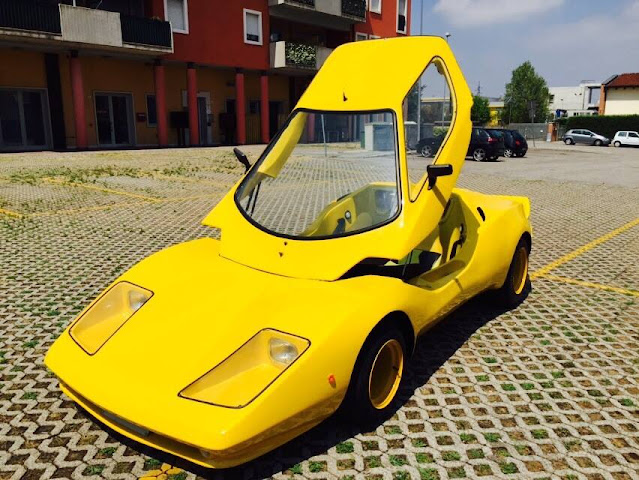The Puma GTV, an Italian Nova
Not to be confused with the Brazilian marque of the same name, Puma was an Italian producer of novel dune buggies, Jeep clones, and a licensed version of Richard Oakes' iconic Nova (aka. Sterling). The company, founded by Adriano Gatto, was very successful producing kits and turn-key cars from the 70's until well into the 1990's.
The Puma GTV was introduced in 1978 and like its British forebear used the humble VW Bug as its donor car. The motors used were tuned by Lombardi and offered in displacements of up to nearly 1.4 liters.
The styling of the car differed in a number of significant ways from the Nova, however. The wheel wells were flared slightly and smoothed over in such a way to more closely contain the tires. The canopy roof assembly was also hinged at its most forward point and raised directly forward like a hood might, rather than lifting up completely from the body and forward.
 |
| Gently flared wheel arches and front hinged canopy distinguish the Puma GTV from the UK Nova |
The car was well received and found starring roles in many Italian films including: "The teacher at the sea with the whole class" with Alvaro Vitali and Lino Banfi (1980) - " Mani di Velluto " with Adriano Celentano (1979) - " This is That "with Renato Pozzetto and Nino Manfredi (1983).
In 1984, the design was revised in the form of the GTV-033 model, which was characterized by different bodywork and a change in drivetrain. The VW Bug motor replaced with the 4-cylinder "boxer" derived from the "Alfa Sud" 1186 cc.
 |
| The original Puma GTV-033, with its original "bug-eye" headlights |
The nose was shorter than the first series with the headlights recessed into the body almost to recall the front of the "Puma GT" dune buggy. The rear was more rectangular and the sides were no longer rounded at the bottom, their new shape was inspired by side skirts of the racing cars of that period.
 |
| The Puma GTV 033S |
Due to less than favorable reception, the GTV-033 was revised in 1985 and called the 033S. This version retained the popular Alfa Romeo drivetrain but the front end was restyled in such a way to retain the appeal of the earlier GTV's. It remained in production until 1991.
 |
| The Puma Boxer 90 and an earlier GTV, showing their differences |
In 1990, Puma introduced the "Boxer 90" which was a significant departure from the earlier GTV's. The most radical change was the addition of gull-wing doors which replaced the canopy roof. Styling was decidedly modern with integrated aerodynamic enhancements including a deep front air dam, side-skirts, and a rear valence.
The interior was also more refined with higher quality materials and a more driver centric "cockpit". Leather and briar wood trimmed interiors were available.
The Boxer 90 was offered in both kit and turn-key forms. It was claimed that the kit could be assembled with basic tools in 200 hours or less. A total of 40 were made, with 19 currently accounted for in the (Italian) Puma Registry.
The Boxer 90 was offered in both kit and turn-key forms. It was claimed that the kit could be assembled with basic tools in 200 hours or less. A total of 40 were made, with 19 currently accounted for in the (Italian) Puma Registry.
 |
| The Puma 248 |
The planned successor to the Boxer 90 was the Puma 248, of which a single example was made. The 248 was built on a newly designed chassis, had a further refined leather interior, and was powered by a 1,700 cc - 16V engine again from Alfa Romeo.
Unfortunately, in 1993 Puma was forced by Italian legislation, which had become more increasingly restrictive towards Kit-Cars, to close its doors. The new laws effectively blocked the activities of small manufacturers, for bureaucratic reasons, and unable to bear the very high costs required for the homologation procedures many specialty car producers met the same fate.
After closing the business, Adriano Gatto sold the name "Puma" to Ford.
Special thanks to Domingo Federico, President of Puma Club Italy for information and pictures featured here.
Sources:
Puma Club Italy
The Italian Puma Registry
Sources:
Puma Club Italy
The Italian Puma Registry
 |
| Puma GTV |
 |
| Puma GTV interior |
 |
| Puma GTV and Boxer 90 |
 |
| Puma GTV and Puma GT dune buggy |
 |
| Puma GTV-033 |
 |
| Puma GTV-033 |
 |
| Puma 248 |
 |
| Puma Boxer 90 |






Comments
Post a Comment